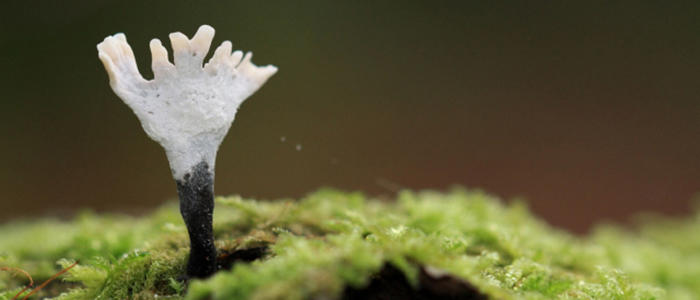Pioneer fungi start degrading dead wood before it hits the ground
Posted on April 5, 2017 by Benjamin Thompson
Next time you go walking in a forest during the summer months, take a look up and see if you can spot any branches missing their leaves. It might not seem obvious at first, but you’re looking at a poorly understood, although rather important, ecosystem.

As a tree grows, the branches nearest the base can become starved of light as the canopy spreads out above them, meaning that they use more energy than they create. Some types of tree actually ‘self prune’ these leafless branches, dropping them to the ground, where they get broken down by micro-organisms, returning their nutrients to the soil.
However, far from being dead weight, these limbs are actually vessels for numerous species of pioneer fungi that appear to be involved in the early decay process, while a branch remains attached to its tree. These fungi are able to break into parts of the wood that other fungi can’t reach, hastening the branch’s fall.
Conditions up in the trees are certainly harsher than down on the ground – with larger temperature swings, for example – but these fungi appear to thrive at these heights, before quickly being outcompeted by other species once a branch hits the ground.
Learning more about these obscure micro-organisms is Anna Rawlings, a PhD student from Swansea University, who is presenting a poster about her work today at the Microbiology Society’s Annual Conference 2017. Anna is researching the fungi living in dead beech tree branches to get a better idea of the ecological web present in the canopy.
To date, she has removed 16 dead branches from trees in Clyne Valley Country Park, Swansea, and dissected them, identifying 85 species of fungi that exist in highly variable communities. Some species can be found along an entire length of a branch, for instance, while others are only in specific areas.
It’s not yet understood why these spatial differences exist, or why one branch’s fungal community is so different to another, but Anna and her colleagues are hoping that this work will start to uncover how they come about.
“Researchers have surveyed countless logs and branches on the forest floor, and are very familiar with the types of fungi that establish in these conditions,” she explains.
“However, the total number of branches that have been surveyed in the canopy is less than 500. I’ve identified 85 species associated with beech, but there are likely many more to discover. This is surprising in itself because if you look at work on oak or hazel trees, only about 10 fungal species make up the decay communities in these hosts, which is very different.”
Fungi have a key role to play in degrading and digesting dead trees and wood – without them we’d be drowning in logs, but until now this work has concentrated on the woodland floor. This new research suggests that decomposition actually starts several feet aboveground on the lowest hanging branches – and that to understand the process fully, we need to turn our gaze upwards.
